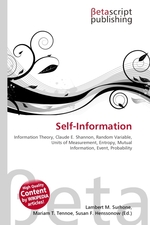Self-Information
Lambert M. Surhone, Miriam T. Timpledon, Susan F. Marseken
бумажная книга
High Quality Content by WIKIPEDIA articles! High Quality Content by WIKIPEDIA articles! In information theory (elaborated by Claude E. Shannon, 1948), self-information is a measure of the information content associated with the outcome of a random variable. It is expressed in a unit of information, for example bits, nats, or hartleys, depending on the base of the logarithm used in its calculation. The term self-information is also sometimes used as a synonym of entropy, i.e. the expected value of self-information in the first sense, because I(X;X) = H(X), where I(X;X) is the mutual information of X with itself. These two meanings are not equivalent, and this article covers the first sense only. For the other sense, see entropy. By definition, the amount of self-information contained in a probabilistic event depends only on the probability of that event: the smaller its probability, the larger the self-information associated with receiving the information that the event indeed occurred.
Данное издание не является оригинальным. Книга печатается по технологии принт-он-деманд после получения заказа.


